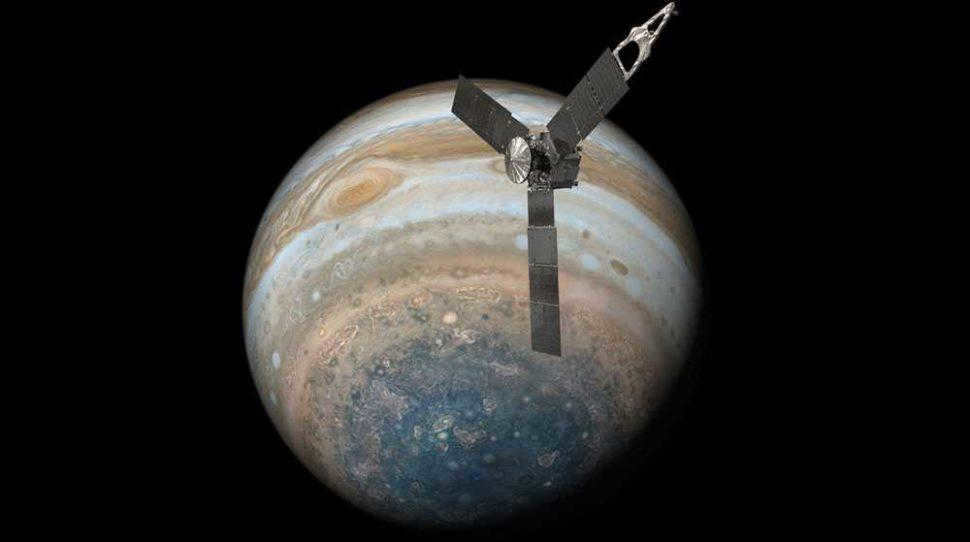
Jupiter, which lies between Mars and Saturn, is the fifth planet in our solar system. What are some of the most captivating details about this fascinating celestial body?
The Largest Planet in the Solar System
Jupiter holds the title for being the largest planet in our solar system, second only to the Sun itself. With a radius measuring 69,911 kilometers, Jupiter reigns supreme in terms of size. In fact, it surpasses Earth in mass by a staggering 317 times and in volume by a whopping 1,321 times! To put this into perspective, if we were to combine the masses of all the other planets in our solar system (excluding Jupiter), they would still be 2.5 times lighter than Jupiter.
Interestingly, despite its immense size, Jupiter is composed of matter with an extremely low density. Clocking in at 1,326 kg/m3, the density of Jupiter is only a mere 30% greater than that of water. This peculiar characteristic sets Jupiter apart from other celestial bodies in our solar system.
There is no visible top layer
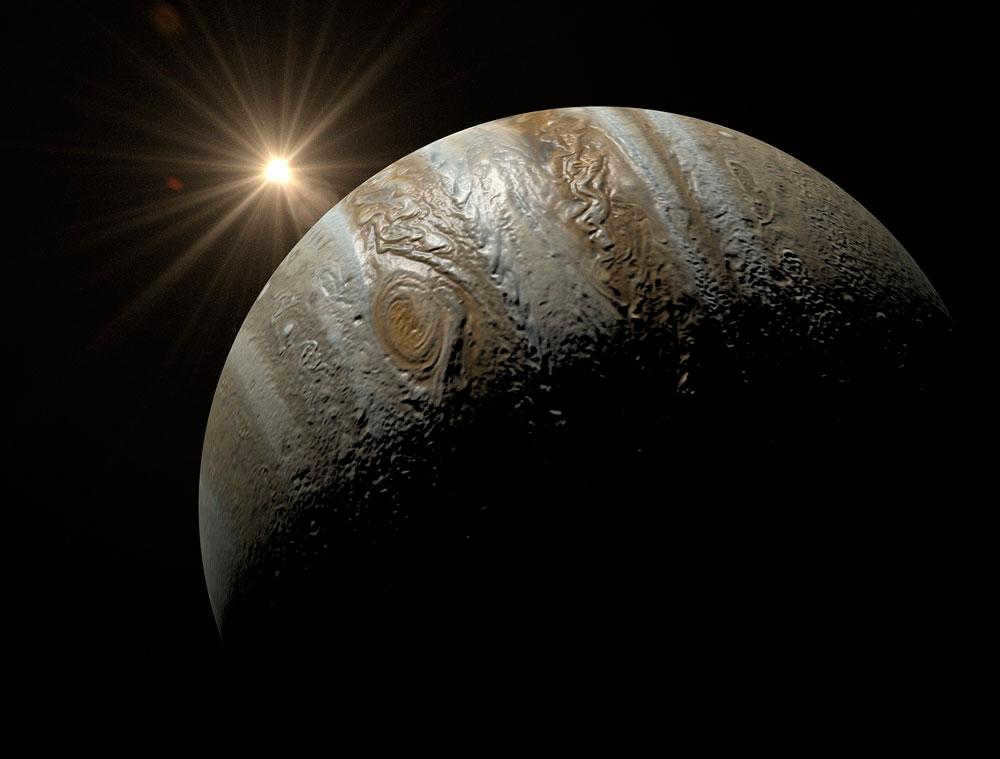
Walking on the surface of Jupiter is an impossible task for humans. This is because Jupiter is a gas giant, composed mainly of compacted gases deep within the planet. The intense pressure causes the atmosphere to smoothly transition into a liquid ocean. It is widely believed that the “surface” of Jupiter exists at the level of its atmosphere, where the pressure is equivalent to 101,000 pascals – a pressure observed on Earth at the bottom of the world’s oceans.
The primary component of Jupiter is hydrogen
Determining the exact chemical makeup of Jupiter’s interior is a challenging task, but scientists believe that the planet is composed of approximately 89% hydrogen. Helium makes up about 10% of the planet’s mass, with trace amounts of other elements present.
In the upper atmosphere, hydrogen exists in the form of clouds, while in the deeper layers, it forms a vast ocean of liquid hydrogen. Even deeper down, there exists a layer of metallic hydrogen, a substance that cannot be replicated under normal terrestrial conditions due to the immense pressure required for its formation—millions of atmospheres. On Jupiter, the layer of metallic hydrogen is estimated to be around 46,000 kilometers thick.
Not Exactly Orbiting the Sun
In our education, we have learned that planets orbit their respective stars. However, the reality is a bit more complex. Both the star and the planet orbit around a shared center of mass. Typically, due to the immense mass of stars, this center is located within the star itself. Nevertheless, Jupiter is an exception to this rule.
Due to Jupiter’s significant mass, the center of mass of the Sun-Jupiter system resides not within the Sun, but slightly above its surface. Interestingly enough, Jupiter revolves around a point that is independent of the Sun.
A big crimson dot
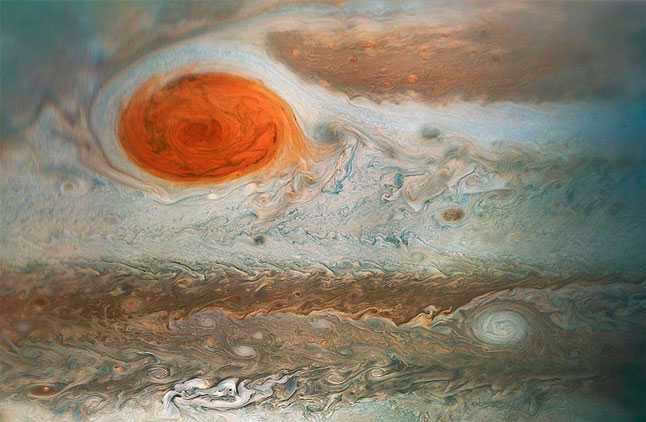
Jupiter’s atmosphere is a hub of numerous storms, but the most prominent one is the Great Red Spot (GRS), an anticyclone that has been active since its discovery in 1665. Despite its longevity, the spot has been gradually shrinking in size. While it once spanned 40,000 kilometers in length, it has now reduced to 16.5 thousand kilometers.
The wind speed within the BKP reaches a staggering 500 kilometers per hour, and the temperature inside this region drops as low as -160 ° C. The future lifespan of this anticyclone remains a mystery to astronomers.
The 1994 Attack
Due to its immense size, Jupiter is frequently targeted by comets and asteroids more frequently than any other planet. In fact, in 1994, humanity witnessed the first-ever collision between two celestial bodies within our Solar System: the Shoemaker-Levy 9 comet collided with Jupiter.
At the time of impact, the comet had already broken up into 21 fragments, each with a diameter of approximately 2 km. These fragments were hurtling through space at a speed of 64 km/s. Consequently, the collision resulted in the formation of visible spots in Jupiter’s atmosphere, which were observed by astronomers for a significant period of time. The impact of the largest fragment released an energy equivalent to 750 times the power of all the nuclear weapons on Earth!
The briefest day
In spite of its massive magnitude, Jupiter is the planet that rotates on its axis with the greatest speed. A solitary day on Jupiter has a duration of less than 10 hours. Due to this swift rotation, the centrifugal forces cause a slight expansion of the planet’s equator, resulting in a flattened appearance at the poles. Consequently, the equatorial radius of Jupiter is 7% greater than its polar radius.
Rains of diamonds
There is a hypothesis among scientists that Jupiter and Saturn experience peculiar meteorological events, during which diamonds descend from the skies! The reason behind this phenomenon lies in the abundance of methane in their atmospheres. When lightning strikes, the methane transforms into soot. Subsequently, this soot plunges into the depths of Jupiter, where it undergoes escalating pressure. This immense pressure triggers the conversion of soot into graphite, and eventually, into diamonds. It’s worth mentioning, however, that the size of these diamonds is minuscule, and they bear no resemblance to the precious gemstones commonly used in jewelry.
Satellites
Satellites are objects that orbit around a larger object in space. They can be natural, like the moon, or artificial, like the many satellites that humans have launched into space. These artificial satellites serve a variety of purposes, including communication, weather forecasting, and scientific research. Satellites can provide valuable data and information to scientists and researchers on Earth, helping to improve our understanding of the universe.
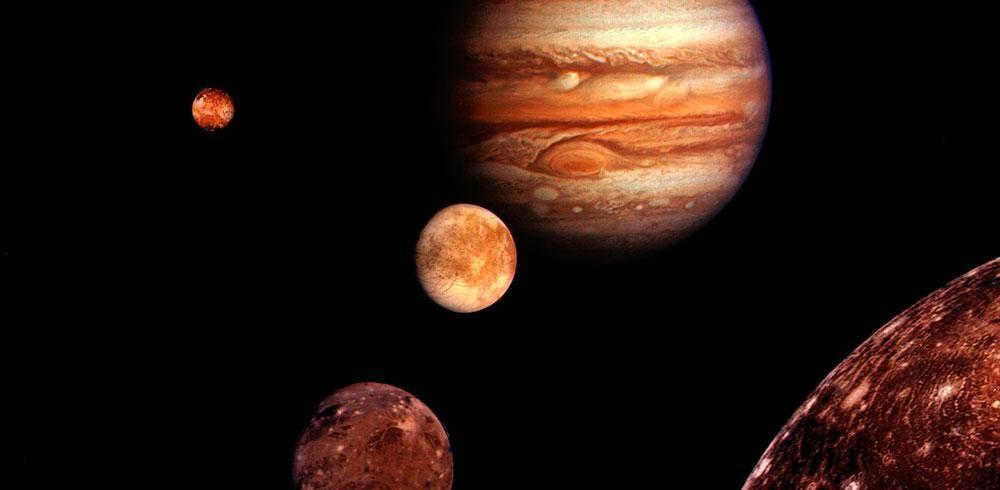
Jupiter became the inaugural planet in the solar system to possess moons (excluding the Moon). In 1610, Galileo, the pioneer in history to direct a telescope towards the heavens, observed four substantial entities encircling Jupiter, which he labeled as Io, Ganymede, Callisto, and Europa. This revelation indirectly verified the accuracy of Copernicus’ heliocentric representation of the universe.
At present, there are 79 known satellites of the planet, with Ganymede standing out in particular. It is the largest moon in the solar system, boasting a radius of 2634 km. Remarkably, its size even surpasses that of the planet Mercury, which has a radius of 2439 km.
Scientists are particularly interested in the Europa satellite. The surface of Europa consists of ice with numerous cracks and minimal craters. This suggests the possibility of a liquid water ocean beneath the ice, which could potentially support life.
Interestingly, Jupiter’s satellites, Themisto and Dia, were once considered “lost” as their orbits could not be accurately calculated, making it difficult for astronomers to observe them. However, after some time, these satellites were rediscovered and were no longer considered “lost”.
Trojan asteroids
In Jupiter’s orbit, there exist two sets of asteroids that travel at the same angular velocity as the planet itself. It appears that they remain relatively stationary in relation to Jupiter.
The first set is known as the Trojans, positioned approximately 60° behind Jupiter. On the other hand, the second set, called the Greeks, is located 60° ahead of Jupiter. Together, these two groups consist of over 6,000 asteroids, with the “Greeks” being more abundant. Currently, scientists are unable to determine how these asteroids came to occupy their present orbits or what their future destiny may hold.
Related articles
List of sources used
– https://www.factroom.ru/facts/12803/ – http://obshe.net/posts/id2042.html – https://nauka.vesti.ru/article/1039043 – https://ru.wikipedia.org/wiki/Юпитер
What are the hues of the celestial bodies in our solar system? The rationale behind Jupiter’s distinction as a planet rather than a star, and the intensity of its magnetic field.
Response by Andrey Egorov [newcomer]
distinctive
Response from Korosta [active].
Mercury is a planet that appears gray in color. This gray color is a result of the planet’s lack of atmosphere and water, leaving only rock as its predominant feature. Venus, on the other hand, has a yellowish white color, which is primarily due to the presence of clouds that surround the planet. These clouds are made up of hydrochloric acid vapor, giving Venus its distinct hue. As for Earth, it is commonly referred to as the “Blue Planet” because of its predominantly blue and light blue appearance. This color is largely determined by the planet’s vast water cover. Mars, also known as the “Red Planet,” actually has a red-orange color. This color is a result of the iron-rich desert soil that covers its surface. Moving on to Jupiter, this giant planet has a main color of orange-yellow and is characterized by its colored bands. These colors are formed by the presence of clouds made up of ammonia and ammonium gases. Saturn, on the other hand, is pale yellow in color, also due to clouds of ammonia. Beneath these ammonia clouds lies a layer of liquid hydrogen. Uranus stands out with its light blue color, which is formed by methane clouds. Unlike Earth, where water determines the color, Uranus relies on methane to create its distinct hue. Neptune, often referred to as a green planet, is actually more of a shade of blue. Its color is determined by the presence of methane clouds, similar to Uranus. However, Neptune’s surface appears darker due to its greater distance from the Sun. Finally, Pluto has a light brown color, which can be attributed to the presence of dirty methane ice on its surface.
Reply from the expert in the field of essential things
Mars experiences azure sunrises and crimson atmospheres throughout the daytime (assuming you were a resident of that planet).
Response from Eurovision [guru]
The planets in our solar system often exhibit distinct variations in color.
Here are the true colors of each planet:
Mercury: characterized by a gray hue due to its lack of atmosphere, revealing only its rocky surface.
Venus: appears yellowish white, with a thick layer of colorless and featureless sulfuric acid clouds.
Earth: displays a light blue color, attributed to the presence of oceans and the scattering of light by the atmosphere. Different areas of the Earth may show brown, yellow, and green continents, or be covered with white clouds.
Mars: exhibits a red-orange color, primarily due to the presence of iron oxide, which gives its soil a red hue.
Jupiter: showcases orange and white streaks. The white streaks are formed by ammonia clouds, while the orange streaks are a result of ammonium hydrosulfide clouds. Since the “gas giants” (Jupiter, Saturn, Uranus, and Neptune) lack solid surfaces, we can only observe their atmospheric clouds.
Saturn: presents a pale yellow hue, covered by a white haze of ammonia that partially obscures the red clouds below.
Uranus: displays a light blue color, mainly due to the presence of methane clouds.
Neptune: also appears light blue, similar to Uranus, because of the methane in its atmosphere. However, Neptune’s surface appears darker than Uranus due to its greater distance from the Sun.
Pluto: characterized by a light brown color. Since no spacecraft has ever visited Pluto, the assumption is that its surface is covered in dirty methane ice, providing the light brown hue.
Response received from Mr. Michael [guru].
The color of Mercury is gray, Venus is a combination of white and poisonous green, Earth appears blue, Mars has a pale orange-rusty hue, Jupiter is streaked with white and brown, Saturn has a light beige color, Uranus is grayish-blue, and Neptune is bright blue.
Reply from Vladislav [guru]
Please refrain from using drugs.
Response from Ѐustam Iskenderov [guru].
Mars has been known as a “red” (or reddish) planet for centuries. I don’t recall the exact color, but I believe either Saturn or Jupiter has a bluish tint.
Jupiter, the fifth planet from the Sun, is a gas giant that measures 145,000 km in diameter. It is the largest planet in our solar system, with a diameter 11 times larger than that of Earth. In terms of mass, Jupiter is even more superior, as its mass is 318 times greater than Earth’s. This massive planet has a total of 60 satellites in its orbit, but only four have been actively explored: Ganymede, Europa, Io, and Callisto. If you’re seeking the most unusual weather patterns, Jupiter is the place to go.
Jupiter
Jupiter is composed mainly of two gases, hydrogen and helium, making it one of the lightest planets in the universe. Its day lasts just 9.9 hours, while its year, the time it takes to orbit the Sun, is 11.86 Earth years. What sets Jupiter apart from other planets is its unique color. Additionally, it is also the largest planet in our solar system.
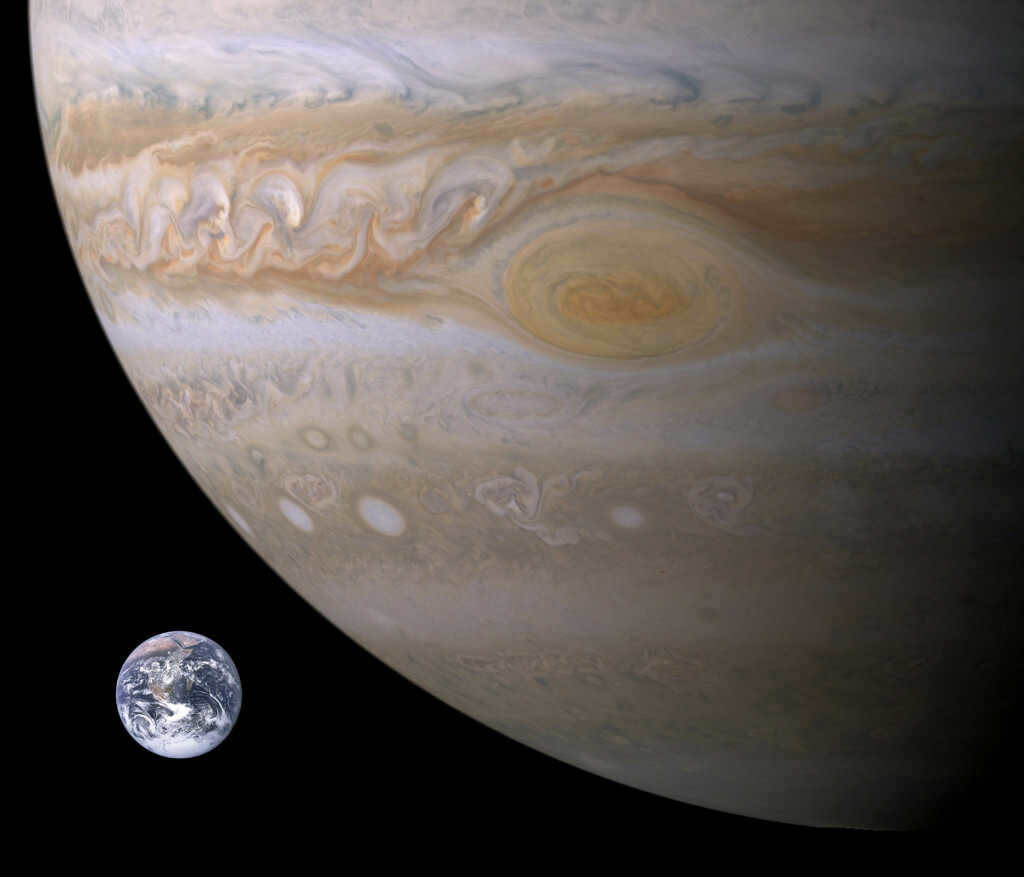
The aim of scientists is to investigate the characteristics of this gas giant, including the presence of water and a solid surface. In order to accomplish this, they plan to deploy a research center. Given that Jupiter is primarily composed of hydrogen, a special balloon will be required for the mission. It should be noted that hydrogen is a lightweight gas, meaning that a helium balloon would descend towards the planet’s core. To counteract this, the balloon will need to be filled with hot hydrogen, as the cold hydrogen atmosphere would cause it to sink. However, it is important to acknowledge that heating hydrogen is a challenging task. Consequently, the origins of this colossal sphere remain a mystery.
The Unique Color of Jupiter
Jupiter possesses an exceptionally distinctive color, unlike any other planet in our solar system. Its atmosphere primarily consists of hydrogen gas, but also includes various other gases, such as ammonia. The planet showcases striking stripes, making it challenging to assign a specific color to Jupiter. The white stripes originate from ammonia clouds, while the orange stripes stem from ammonium hydrosulfide. Since Jupiter is believed to lack a solid surface, its entirety is composed of these cloud formations.
Jupiter acts as the guardian of Earth
The presence of Jupiter in our solar system plays a crucial role in safeguarding the planet Earth. This massive gas giant serves as a protective shield, preventing meteorites and asteroids from colliding with our planet. Thanks to its immense gravitational force, Jupiter captures these hostile space objects and either redirects them back into space or engulfs them within its own atmosphere. By doing so, this colossal celestial body effectively shields the inner solar system from potential impacts, ensuring the safety of all the planets from foreign celestial bodies.
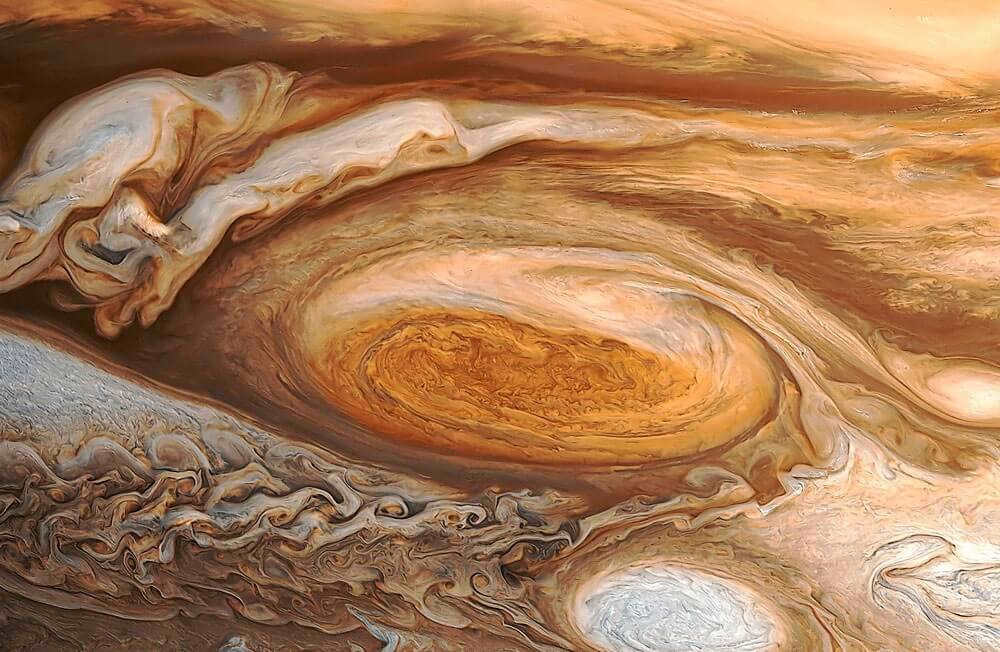
The Red Spot, also known as the Eye of Jupiter, is an immense storm that stands apart from any other storm in the entire solar system. This unfathomable storm has been raging for a minimum of 300 years, making it a truly remarkable phenomenon. The sheer size of this red spot is comparable to the size of our very own planet Earth. It is a mind-boggling thought to ponder what might be occurring within the depths of this colossal storm. Inside the red spot, winds are said to reach incredible speeds of up to 700 kilometers per hour, a force that is unparalleled in our earthly experience. To put it into perspective, the strongest wind ever recorded on our planet Earth was a mere 280 kilometers per hour.
The appearance of a planet’s color largely depends on the composition of its substances. This is why each planet in our solar system exhibits a unique and distinct color. Continuous exploration and research in the field of space science enable us to gather more and more new data, shedding light on the true colors of the planets within our solar system. Additionally, our quest to uncover celestial bodies beyond our solar system is an ongoing endeavor, expanding our knowledge of the vastness of the universe.
The solar system stands out for its vibrant colors
The solar system boasts a limited number of planets. Certain planets were predicted by physicists and mathematicians long before the advent of advanced telescopes. Thanks to subsequent advancements in astronomical science and technology, we have been able to discover and characterize the diverse range of colors exhibited by the planets in our solar system.
So, in order:
- Mercury is a planet that appears gray in color. This hue is the result of the lack of atmosphere and water, as the planet consists mainly of rock.
- Next up is Venus, which has a yellowish-white color due to the clouds that surround it. These clouds are formed from the vaporization of hydrochloric acid.
- Earth is a blue planet with a light blue hue and a covering of white clouds. The predominant color of the planet is influenced by its extensive water cover.
- The planet Mars, also known as the “Red Planet,” actually has a red-orange color. This is due to the presence of iron-rich desert soil, which gives the planet its distinctive hue.
- Jupiter, a massive gaseous planet, is primarily orange-yellow in color, with the presence of various colored bands. These colors are formed by the presence of clouds made up of ammonia and ammonium gases.
- Saturn has a pale yellow hue, which is created by the presence of ammonia clouds. Below these clouds, there is liquid hydrogen.
- Uranus is characterized by a light blue color, which, unlike Earth, is a result of methane clouds.
- Neptune, often described as green, is actually more of a blue shade. Like Uranus, the color of Neptune is determined by the presence of methane clouds. Additionally, its surface appears darker due to its distance from the Sun.
- Pluto has a light brown color, mainly due to the presence of dirty methane ice on its surface.
Are there any other planets
Astronomers and astrophysicists have spent numerous years exploring and uncovering exoplanets, which are planets located outside of our solar system. Advanced telescopes positioned in Earth’s orbit play a crucial role in this quest, capturing images and striving to provide a precise understanding of the colors of these planets. The primary objective of these endeavors is to identify an Earth-like planet capable of sustaining life amidst the vastness of the cosmos.
When searching for planets, the primary factor considered is their luminosity, specifically the way their glow is reflected from the star, resembling the image of Earth. The color of this reflection is not limited to just white-blue. According to scientists, a planet emitting radiation from the red spectrum could also support life. The majority of Earth’s reflection comes from its water surface, resulting in a white-blue glow, while reflection from vegetated land would have a reddish tint.
Currently discovered exoplanets share many characteristics with Jupiter.
In this article, we will discuss an intriguing and practical topic: the relationship between colors and planets.
Each planet is associated with a specific color. Below, I will outline their main characteristics.
The Sun is represented by the color orange.
The Sun represents various aspects of life, such as health, fatherhood, self-assurance, proper nourishment, social progress, and ego. When surrounded by the color orange, you are enveloped in the energetic vibrations associated with these qualities. Additionally, the color orange encourages you to distance yourself from any sources of irritation and seek solitude.
The moon, on the other hand, is characterized by its white, milky hue.
The color white has a calming effect and promotes relaxation. If your bedroom is adorned in white, spending time in that space will help you unwind. When it comes to reading, a white background is the most favorable, as it allows for better focus and attentiveness.
On the contrary, the color red exudes strength and activity. It serves as a stimulus and motivator, propelling one towards action. Red commands attention and serves as a great choice when you want to draw attention to yourself or highlight a project.
Mercury is associated with the color green.
The color green is believed to enhance intelligence and promote faster absorption of information. It is also known to facilitate negotiation and communication. Consider using this color in meeting rooms or children’s rooms.
Jupiter is associated with knowledge, wisdom, learning, and personal development. Incorporating this color into your surroundings can help stimulate these aspects. However, be cautious as it may have a negative impact on individuals who are initially passive and lazy.
This color is often associated with creativity and can be used to attract romantic partners or companions with a romantic nature.
If you desire to replicate the impact of a serious individual and artificially exert dominance over the conversationalist – opt for this hue. Have you observed that businessmen and individuals of gravity are fond of the color black? It truly imparts a sense of structure. However, the drawback is a weightiness in the psyche, a sense of stagnation and sadness. Ladies of charm, it is not necessary to always don black attire. It invites melancholy into your life.
Purple embodies Ketu.
Ketu symbolizes spirituality and metamorphosis. You may employ this shade if you wish to broaden your consciousness, but caution must be exercised as the flip side entails the risk of schizophrenia and severe anxiety.
Typically, these hues are once again employed to garner attention, but they swiftly become monotonous. For instance, you may have glimpsed a vibrant banner on your commute to work, but after a week, it loses its allure and becomes just another banner.
By blending different colors, you can achieve fascinating results. For instance, turquoise-blue is created by combining blue with a hint of green. This color is known to have a calming effect on the mind and body. Additionally, it can help reduce aggressiveness and enhance emotional stability.
Here’s another example. Brown is obtained by mixing red with green (which is a combination of red, yellow, and blue). This color is often associated with a sense of tranquility and reliability. Dark shades of brown may evoke gloominess, but lighter shades can provide a feeling of security. People who prefer wearing such shades are generally characterized by their strong and composed nature, or simply have a preference for blending in with the crowd.
Experiment with colors and achieve the desired effects!
If you explore the vastness of the Internet, you’ll notice that the same planet in the solar system can appear in various colors. One source may depict Mars as red, while another may show it as brown, leaving the average user questioning, “Which one is true?”
Many people are concerned about this question, so we have taken it upon ourselves to provide a definitive answer to eliminate any disagreement. Today, we will reveal the true colors of the planets in our solar system!
The color is actually gray, due to their minimal atmospheres and rocky surfaces which are covered in large craters.
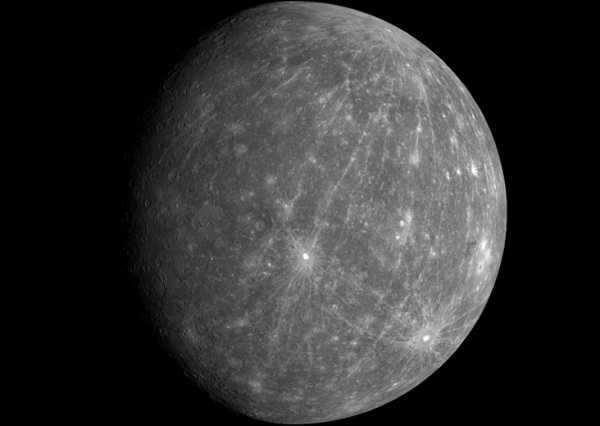

The hue of Jupiter is yellowish-white due to the presence of a thick layer of clouds composed of sulfuric acid.
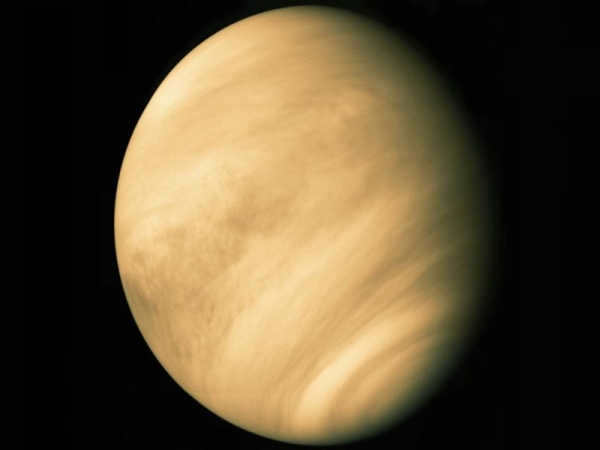
The hue of our planet is light blue, which is primarily due to the presence of oceans and atmosphere. However, when observing the continents, one can notice various shades of brown, yellow, and green. From a distance, our planet resembles a delicately colored blue balloon.
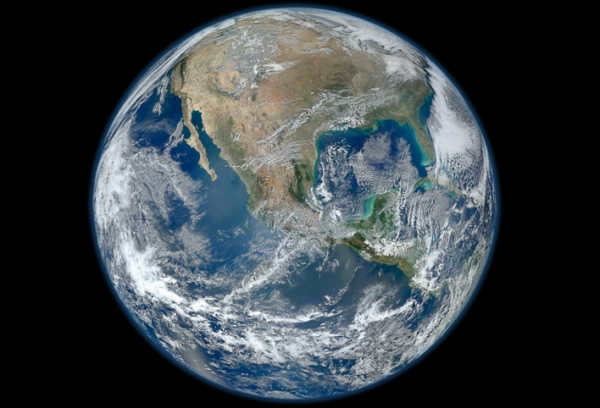
Jupiter has a vibrant hue that can be described as a striking blend of red and orange. Its unique color can be attributed to the abundance of iron oxides present on the planet’s surface, which imparts a distinct hue to the soil.
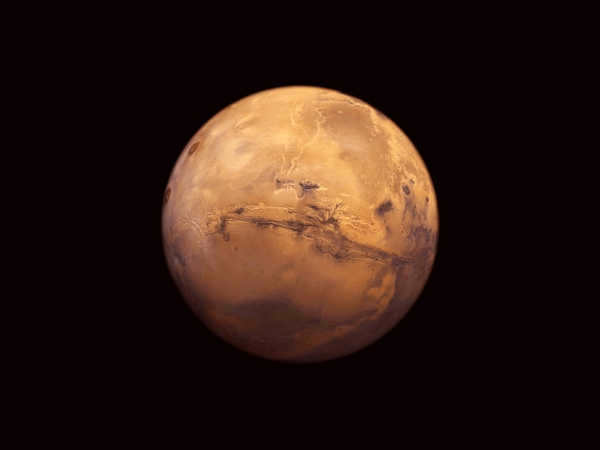
Jupiter has an orange color with white accents. The orange hue is a result of the presence of ammonium hydrosulfide clouds, while the white elements are caused by ammonia clouds. It is important to note that Jupiter does not have a solid surface.
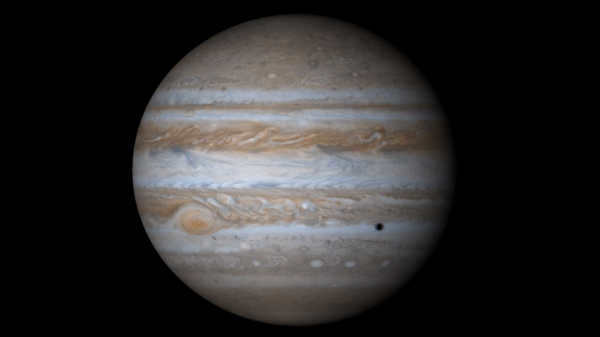
Jupiter has a unique color, appearing as a light yellow hue. This unique color is due to the presence of red clouds covered by a thin layer of white ammonia clouds, creating the illusion of a light yellow shade. It’s important to note that Jupiter does not have a solid surface.
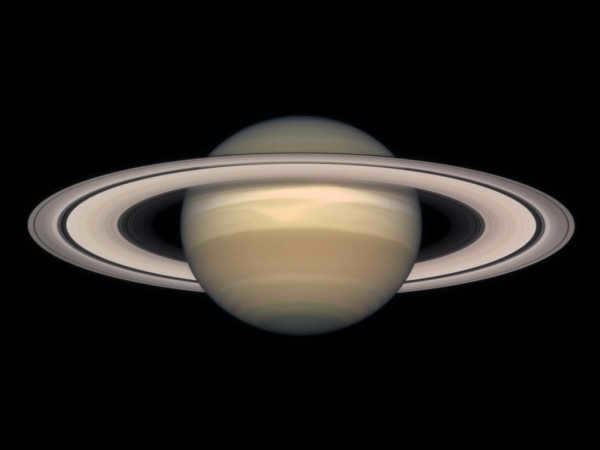
The hue of the methane clouds on Jupiter is characterized by a pale blue color, and it is worth noting that the gas giant lacks a solid surface.
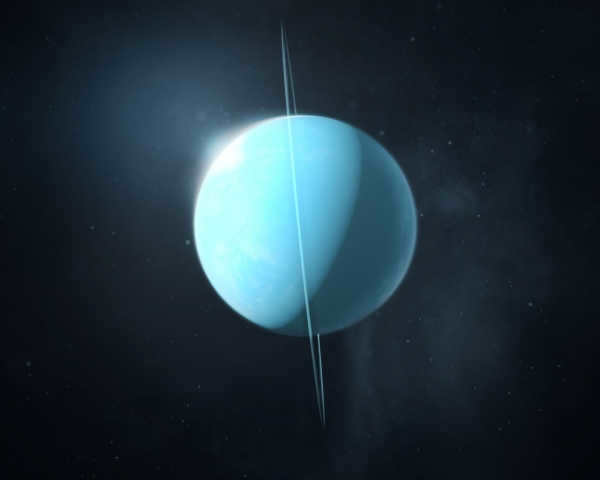
The hue is a soft shade of blue. Similar to Uranus, it is enveloped in clouds of methane, yet due to its greater distance from the Sun, it gives off a more somber impression. It lacks a tangible surface.
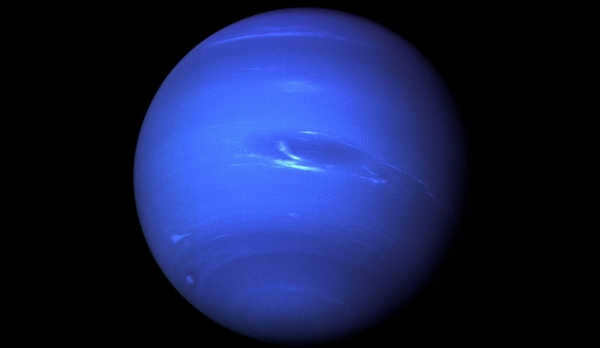
Pluto: The color of Pluto is a delightful light brown shade, which is a result of its rocky surface and icy crust.
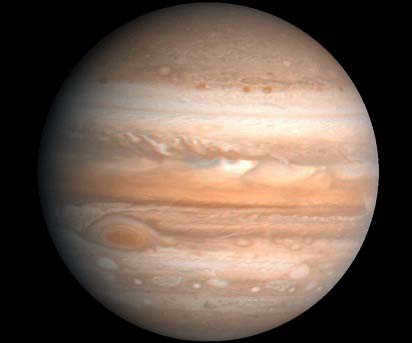
The largest planet in the solar system is Jupiter. It is situated in the fifth position from the Sun.
It is classified as a gas giant and it fully lives up to that classification.
Jupiter was named after the ancient deity associated with thunder. This is possibly because the planet was recognized in ancient times and occasionally appeared in mythology.
Distinctive Features of Jupiter
Mass and Dimensions.
When considering the dimensions of Jupiter in comparison to Earth, the vast differences become apparent. Jupiter’s radius is over 11 times that of our planet.
Moreover, Jupiter’s mass is a staggering 318 times that of Earth! These factors contribute to the comparatively low density of the giant planet, which is nearly 5 times less than that of Earth.
Structure and composition.
The planet’s core, which is quite fascinating, is composed of rock. It has a diameter of approximately 20,000 kilometers.
A layer of metallic hydrogen surrounds the core, with a diameter twice as large. The temperature within this layer ranges from 6,000 to 20,000 degrees.
Following this is a layer consisting of hydrogen, helium, ammonia, water, and various other substances. Its thickness is also around 20,000 kilometers. Interestingly, this layer is gaseous at the surface but gradually transitions into a liquid state.
The outermost layer, known as the outer layer, is primarily composed of hydrogen. There is also a small amount of helium and a lesser quantity of other elements. This layer exists in a gaseous state.
Orbit and rotation.
Jupiter’s orbit is not particularly fast. It takes almost 12 years for the planet to complete a full revolution around the central star.
However, its rotation speed on its axis is quite high. In fact, it is the highest among all the planets in the system. It only takes just under 10 hours for Jupiter to complete one revolution.
About Jupiter
Jupiter’s Atmosphere
The atmosphere of Jupiter is primarily composed of hydrogen (about 89%) and helium (8-10%). It also contains traces of methane, ammonium, water, and other substances. When observed from a distance, Jupiter’s atmosphere displays distinct bands, which represent different layers with varying compositions, temperatures, and pressures. These bands are also characterized by different colors, some lighter and others darker. The movement of these bands is quite fascinating, as they often travel in different directions and at different speeds.
Jupiter’s atmosphere is known for its notable phenomena, such as lightning and storms. These weather events are much larger in scale compared to those on Earth.
Temperature.
Despite its distance from the Sun, the planet experiences extremely high temperatures.
In the planet’s atmosphere, temperatures range from approximately -110 ° C to +1000 ° C. Interestingly, as one moves closer to the planet’s center, the temperature decreases.
However, this decrease is not uniform. Particularly within the planet’s atmosphere, the temperature changes in various layers in a rather unpredictable manner. Currently, scientists have not been able to fully explain all of these temperature fluctuations.
– Because of its rapid rotation, Jupiter is slightly taller than it is wide. This means that its equatorial radius is about 5 thousand kilometers longer than its polar radius (71.5 thousand km and 66.8 thousand km, respectively).
– Jupiter’s diameter is very close to the maximum limit for planets of its kind. If the planet were to continue growing, it would actually start to shrink, and its diameter would remain nearly the same as it is now. This contraction could potentially turn Jupiter into a new star.
– Within Jupiter’s atmosphere, there is an enormous and unstoppable hurricane known as Jupiter’s Red Spot (named for its color when observed). This spot is larger than several Earth diameters, measuring about 15 by 30 thousand kilometers in size (and it has shrunk by half over the past century).
– Jupiter is home to three extremely thin and barely noticeable rings.
– On Jupiter, it actually rains diamonds.
– Jupiter boasts the highest number of satellites among all the planets in our solar system – a total of 67. One of these satellites, Europa, harbors a vast global ocean that plunges down to a staggering depth of 90 kilometers. The volume of water in this ocean surpasses the combined volume of Earth’s oceans, despite Europa being significantly smaller than our planet. The possibility of living organisms existing in this ocean cannot be ruled out.
Saturn
The planet Saturn is renowned for its impressive ring system, as well as its surprisingly low average density. Interestingly, even regular water has a higher density than Saturn!
Neptune
Neptune, the blue-hued planet, is not actually composed of ice as one might assume. Its distinct coloration results from the abundance of methane in its atmosphere.
© Naturae.ru, 2015-2023
Copying of materials from the site is permissible solely with an active hyperlink to the original source.
The colossal gas giant, known as the behemoth of our Solar System, resides in the vast expanse between Saturn and Mars, as it gracefully orbits at a staggering distance of 770 million kilometers from the radiant Sun. On a delightfully clear evening, the majestic presence of Jupiter can be easily observed through a modest telescope or a pair of binoculars, as its luminosity rivals that of the resplendent Moon, the alluring Venus, and the radiant Sun. This awe-inspiring celestial body was bestowed its contemporary appellation by the ancient Romans, who cleverly associated the planet with the preeminent figure of their pagan pantheon, the mighty Jupiter. Immerse yourself in the captivating realm of the planet Jupiter, replete with fascinating tidbits concerning its swirling vortices, mesmerizing auroras, and the legendary Great Red Spot.
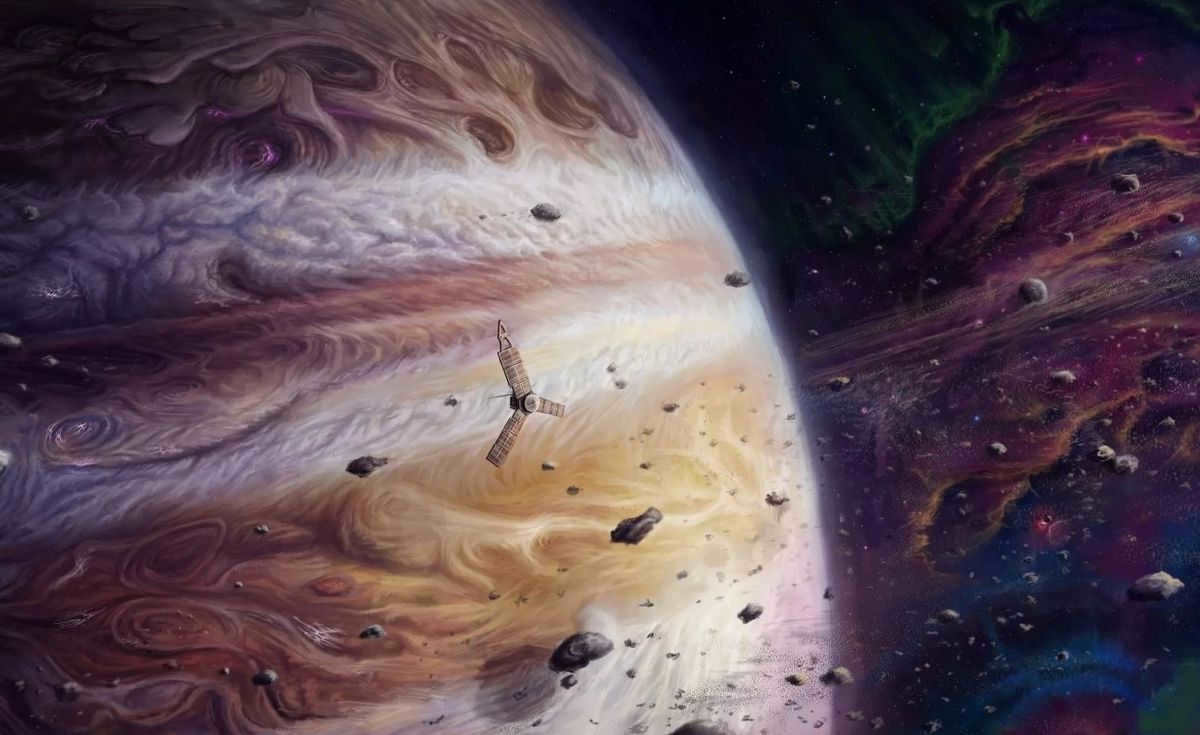
The Colossal Space Entity
Jupiter possesses a mass that is two and a half times greater than the combined mass of all the other planets in our solar system.
The gigantic planet’s equatorial diameter surpasses that of Earth by a staggering 11 times. In terms of volume, Jupiter could easily accommodate a staggering 1300 Earth-sized planets.
This supermassive entity exhibits a flattened shape at its poles and a bulging form at its equator, a consequence of its rapid rotation around its own axis.
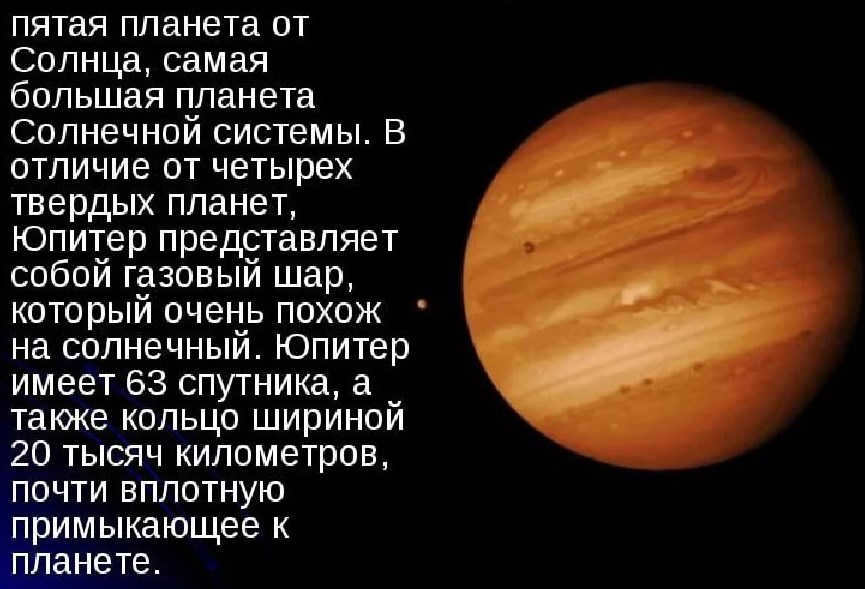
Jupiter’s surface is characterized by its smoothness and lack of mountains or depressions.
Despite its massive size, Jupiter is incredibly agile, completing a full rotation on its axis in under 10 hours.
It takes Jupiter approximately 12 years to complete a single orbit around the Sun.
Unlike Earth, Jupiter does not experience changing seasons.
While on Earth shaded areas are typically cooler than sunlit areas, on Jupiter, the opposite is true: the shadowy surface is significantly hotter than the lighted regions.
In fact, Jupiter releases more energy than it absorbs from the sun’s rays.
The gas giant has a composition that is comparable to that of the Sun.
Jupiter’s core is similar in size to the Earth’s core, but significantly lighter, weighing only one-tenth as much. The core is solid and extremely hot, reaching temperatures of up to 20,000°C. It is surrounded by a mixture of light gases, predominantly hydrogen and helium.
The atmosphere of Jupiter has a brownish-orange color, which is attributed to the presence of phosphorus and sulfur compounds. It is also much denser than Earth’s atmosphere, with a density 18 times greater. The troposphere, the lowest layer of the atmosphere, contains hydrosulfites, ammonia, and frozen water. Temperatures in this layer are extremely cold, ranging from minus 150° to minus 100°C. Above the troposphere is the stratosphere, which is composed mainly of hydrocarbons. Further above is the thermosphere, which is heated to temperatures as high as 725 °C.
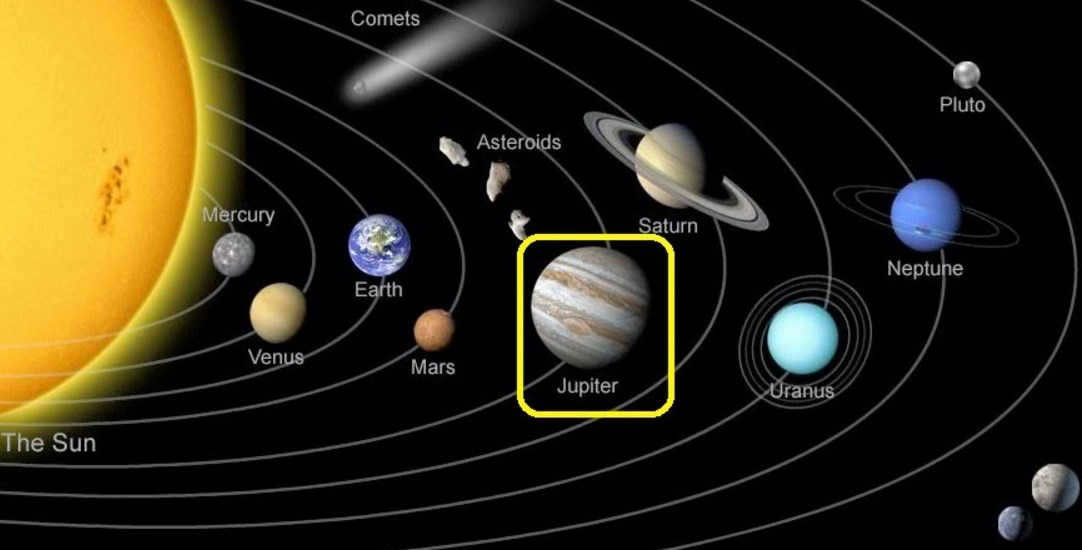
Jupiter is an intriguing celestial body. In comparison to earthly measurements, this supergiant planet is considered to be the most affluent astronomical object due to the occurrence of diamond rain on its surface.
Enormous lightning storms on Jupiter cause the transformation of methane gas into carbon. As these storms approach the planet’s surface, the carbon compound solidifies and undergoes a metamorphosis into graphite. Continued lightning activity then converts the graphite into diamonds. Upon reaching the core of the planet, the diamonds melt, creating a hypothetical boundless sea of liquid carbon.
The equatorial region of Jupiter is adorned with colossal bands that have been observed and recognized by both amateur and professional astronomers for a significant period of time. Despite extensive study, no single hypothesis has been universally accepted regarding the origin of these distinctive stripes.
The stunning coloration of the planetoid is a result of the stratification of gaseous layers that give rise to the extraordinary red and white bands of the Fifth Planet. The red bands are scorching hot, while the white zones have comparatively lower temperatures.
Tornadoes and polar lights
The fifth planet is a realm of powerful winds and tempests. Its primary driving forces are the scorching currents from its core and the kinetic energy generated by its rapid rotation on its axis.
The velocity of the winds on this planet exceeds 600 kilometers per hour.
On the surface of Jupiter, one can observe numerous clusters of anticyclones and cyclones. The cause of these atmospheric anomalies remains unknown.
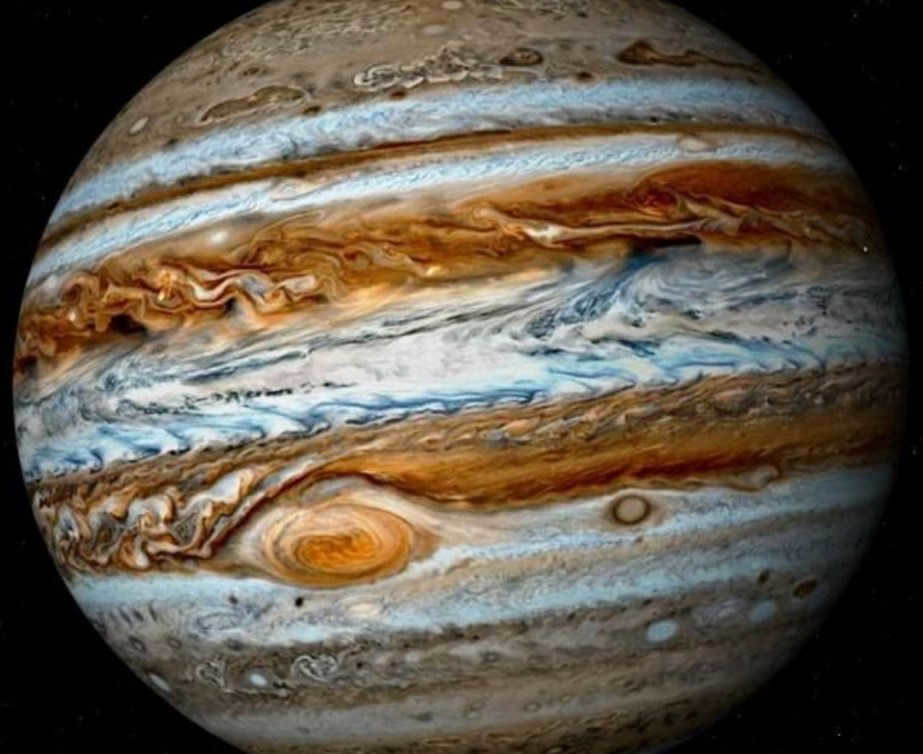
Monstrous lightning flashes on the gas giant surpass Earth’s celestial visitors in length and power by a thousand times.
There is a bright glow near the poles. This phenomenon is constant, although its intensity varies. The aurora consists of three main elements: a central bright beam, hotspots, and pulse emissions within the main zone.
Jupiter’s auroras outshine the northern lights on Earth in terms of color intensity and the vastness of the area they cover (which is larger than the Earth’s surface).
Gravity
The gravitational force is 2.5 times stronger than that of Earth. If you place a 100-kilogram object on a massive planetoid, its weight will increase to 250 kilograms.
The gravitational force of a planet alters the paths of comets, drawing them towards it. A fascinating fact about Jupiter is that it acts as a shield, safeguarding the planets in the solar system from incoming celestial debris.
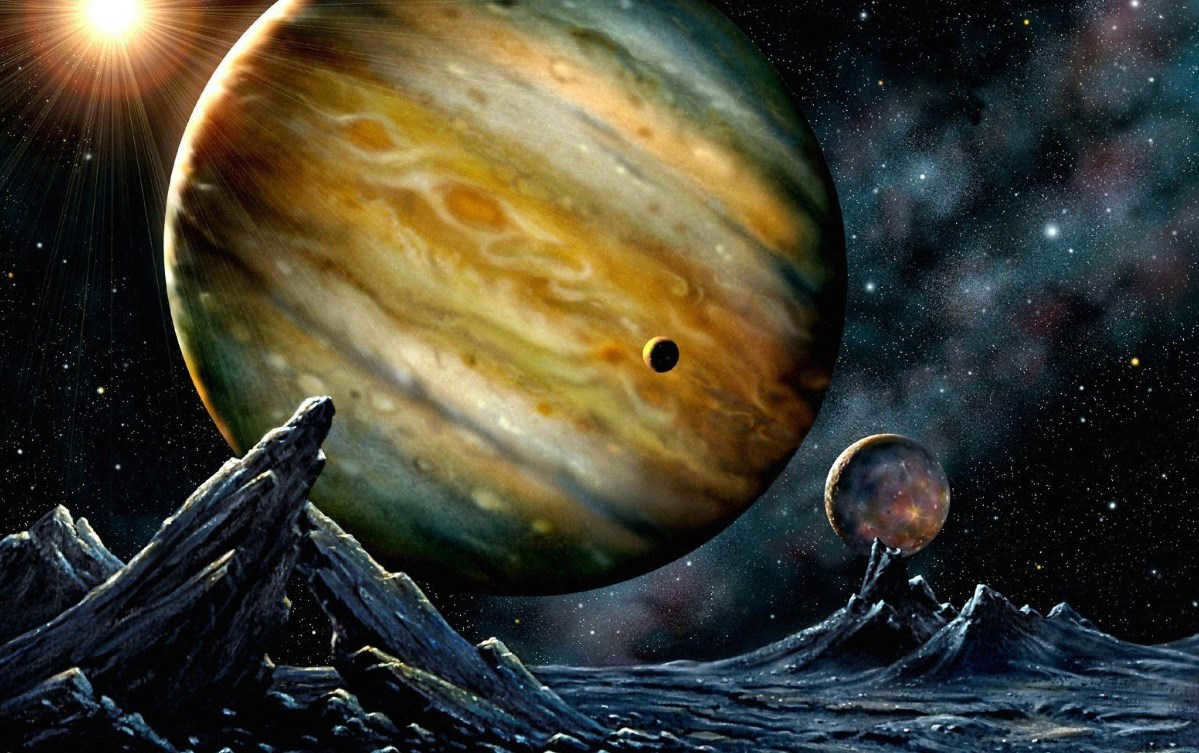
It is hypothesized that the formation of our planetary system was influenced by the gravitational force of the supergiant.
Similar to Saturn, Jupiter also possesses rings. These rings cannot be observed using ground-based equipment, but were discovered by the Voyager-I spacecraft.
The rings are composed of cosmic dust, which is generated through the collision of the planet’s moons with meteors. Jupiter has multiple rings, including the primary ring, the halo (composed of solid dark particles), and the spider ring (transparent and comprised of small satellite fragments). A unique characteristic of Jupiter’s rings is the absence of ice.
The Magnetic Field of Jupiter
Jupiter is renowned for having the most powerful magnetic field in the solar system. It is surrounded by a vast expanse of charged particles, stretching over 650 million kilometers. The magnetic sphere of the fifth planet is approximately 18,000 times stronger than that of Earth.
The level of radiation near this giant is thousands of times more deadly to humans. The bombardment of radioactive particles is so intense that it can even damage highly protected spacecraft. In theory, it possesses enough power to engulf the entire sun.
This massive planet emits sounds that resemble human voices. This phenomenon is known as electromagnetic speech. Some UFO enthusiasts often mistake these “voices” for audio signals from extraterrestrial civilizations.
Jupiter’s Satellites
Jupiter has a total of 67 small satellites and four main moons. This arrangement can be seen as a sort of “Jupiterocentric” system within the larger heliocentric system.
The first four moons of Jupiter – Ganymede, Europa, Io, and Callisto – were discovered by Galileo Galilei in the early 17th century. They appeared as small dark dots against Jupiter’s bright body. The discovery of these satellites provided further evidence for Copernicus’ theory that the Earth was not the center of the universe.
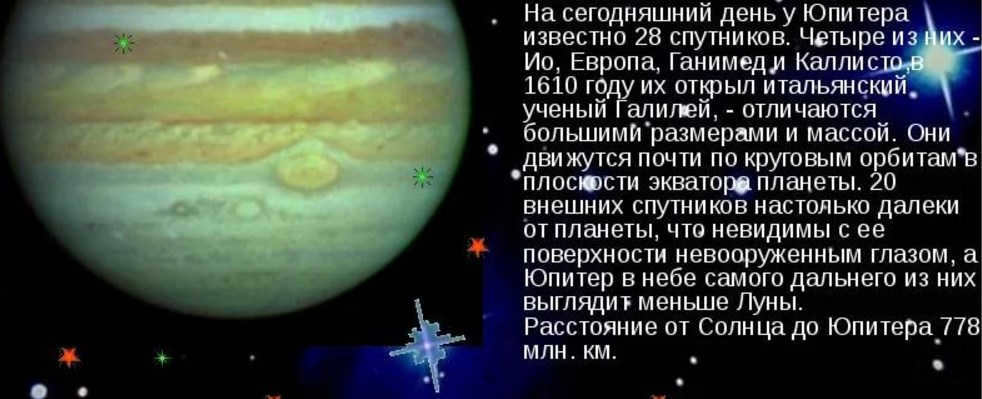
Each of the moons is bigger than Earth’s moon by approximately 1.5 times. The most impressive in terms of size is Ganymede, which has a diameter only 3.5 times smaller than our planet. On the surface of Io, there are 8 active volcanoes, making it the only known celestial object, besides Earth, to have mountains and active volcanoes. Under centuries of ice on Europa, water has been discovered, suggesting the presence of an ocean. Callisto, on the other hand, has no reflectivity and is believed to be made of impenetrable rock.
The density of the satellites varies depending on their distance from Jupiter: the closer they are, the higher their density.
In addition to permanent moons, Jupiter also has temporary moons in the form of comets.
The discovery of the Great Red Spot occurred during the latter part of the 17th century by Giovanni Domenico Cassini.
This well-known egg-shaped blemish, with its distinctive rust color, can be observed in every photograph of Jupiter. It is an anticyclonic vortex that has been persisting for three and a half centuries, with rotational speeds at its core reaching 400 to 500 km/h. The direction of its movement is counterclockwise.
Over a century ago, this spot was as large as our entire planet, but since then it has nearly halved in size. This enigmatic feature undergoes constant transformations, at times expanding in size and growing even more vivid, while at other times contracting and dimming.
However, its position remains unchanging.
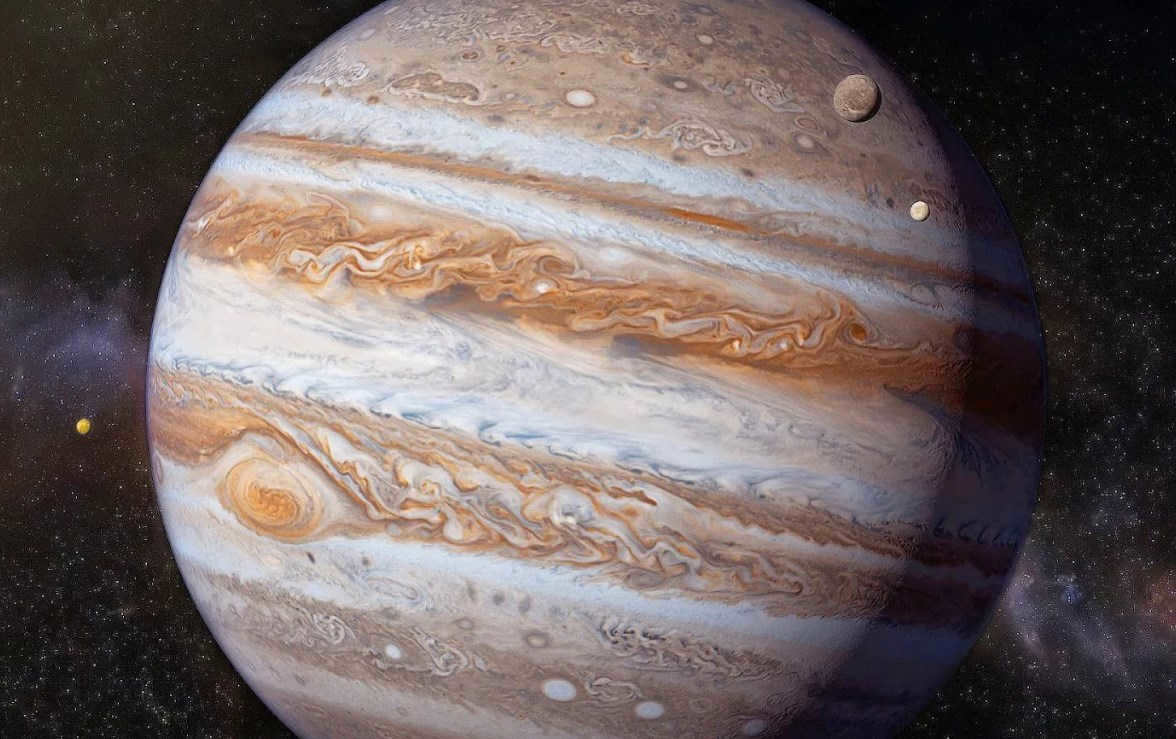
Amazing
The composition of Jupiter’s atmosphere is reminiscent of the atmosphere of ancient Earth. In the latter half of the 20th century, there was speculation about the potential for life in the upper atmosphere of Jupiter, where water vapor exists and conditions such as temperature and pressure could support the development of water-hydrocarbon based lifeforms. However, recent research has cast doubt on this hypothesis, and it has yet to be confirmed.
Hypothetical life forms that could adapt to Jupiter’s unique conditions have been proposed by Austrian physicist Edwin Solpeter and American astrophysicist Carl Sagan. These organisms come in various forms, including tiny, highly reproductive entities resembling viruses, enormous Floaters comparable in size to Earth cities, and hunters that prey on the Floaters. While this information is fascinating, it should be noted that it is presented in the context of speculative fiction.
There is a hypothesis surrounding the potential habitability of Jupiter’s moons: the existence of water on Europa, the production of heat through tidal waves, and the possibility of oxygen being present. However, it is worth noting that life may not necessarily require oxygen. At present, the existence of extraterrestrial life, even in its most basic forms, has yet to be confirmed. As such, this information remains within the realm of science fiction.
Jupiter, the fifth planet in our solar system, is a magnificent and dynamic world. It holds countless secrets that astronomers are eager to uncover. While exploring the vast depths of the universe is an incredible endeavor, our own solar system still holds many mysteries waiting to be unraveled, and Jupiter is certainly one of them.
Jupiter, the fifth planet from the Sun, holds the title of being the largest planet in our solar system. In fact, it is a whopping 2.5 times more massive than all the other planets combined.
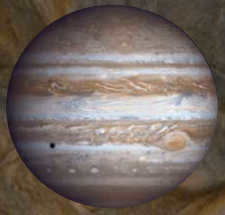

Jupiter accompanied by the shadow of Europa (a small black dot).
Information
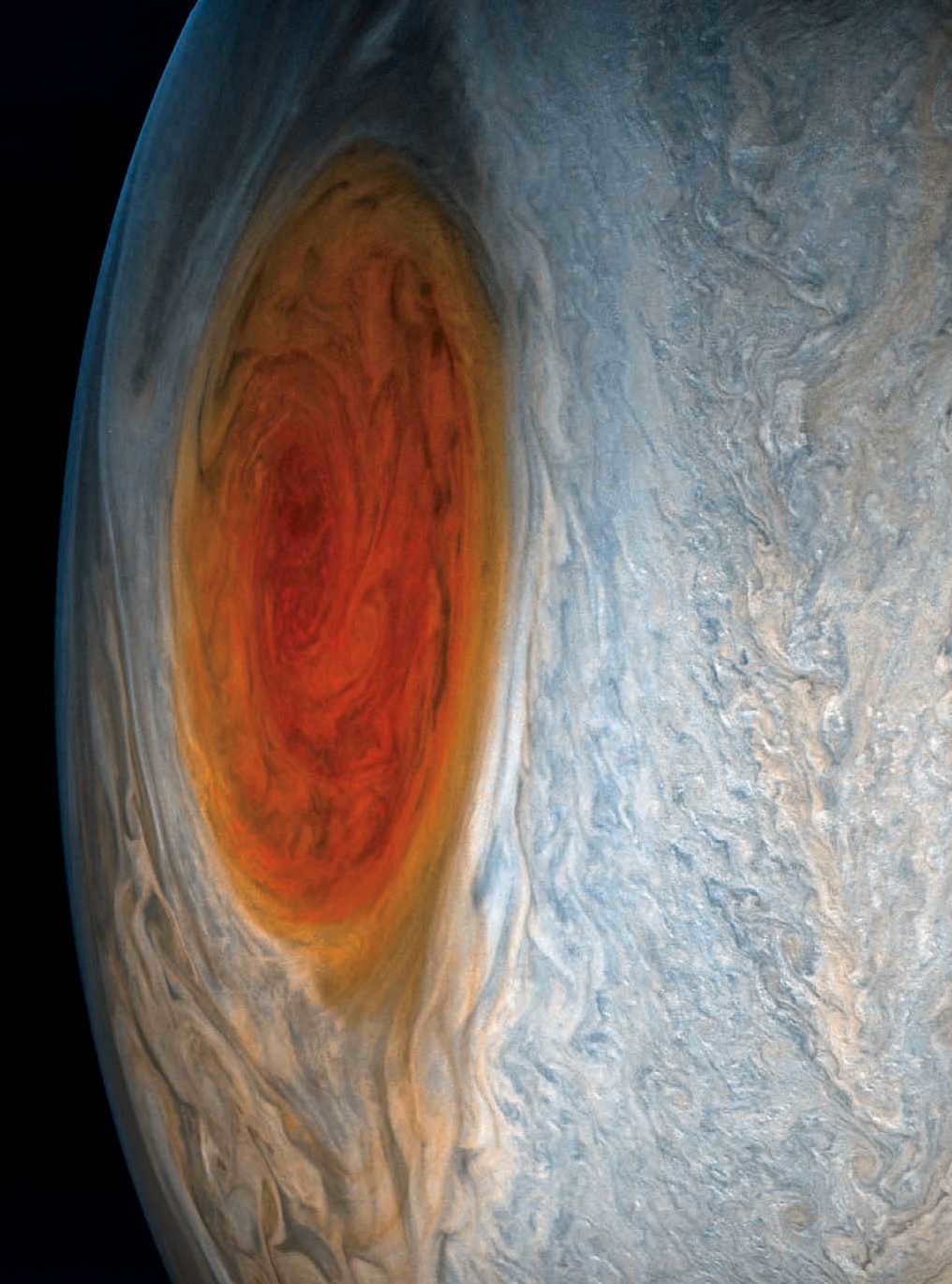

This picture of the Great Red Spot was created using information sent by NASA’s Juno spacecraft.
- Discovered by: unknown
- Time of discovery: prehistoric era
- Named after: ancient Roman god of thunder
- Mass: 317.82 times the mass of Earth
- Volume: 1,321.34 times the volume of Earth
- Average radius: 69,911 kilometers
- Effective temperature: -148 degrees Celsius
- Length of day: 9.92 hours
- Orbital period: 11.86 Earth years
- Number of natural satellites: 79
- Ring system: yes
Description and features of Jupiter
Observing Jupiter through a telescope unveils a breathtaking sight: a multitude of satellites encircling the planet, along with its distinct bands of color. Jupiter, being one of the gas giants, possesses unique characteristics that are shared by all the outer planets in our solar system. Firstly, much like its counterparts, Jupiter lacks what can be considered a solid surface. Descending into Jupiter’s atmosphere can be likened to submerging oneself into a milkshake, where the density of the surrounding matter progressively increases as one approaches the center, causing the gas to transition into liquid and eventually into slush.
Unlike the terrestrial planets within our solar system, Jupiter does not have a solid surface adorned with craters, mountains, or valleys. Its turbulent atmosphere, which boasts a complex structure, undergoes continuous transformations over time.
Jupiter’s atmosphere consists of two different types of clouds, known as dual clouds:
When these air masses collide at their interaction boundary, turbulent zones are created, resulting in powerful hurricanes that orbit the planet at high speeds. Unlike hurricanes on Earth, these storms are stable and can rage in Jupiter’s atmosphere for tens or even hundreds of years without causing any destruction.
Jupiter’s magnetosphere, the magnetic field that surrounds the planet, is similar in structure to Earth’s but is actually 20,000 times more powerful. It captures charged particles from the solar wind, creating massive radiation belts of incredibly high intensity. Any object that is not protected from the effects of radiation will quickly receive a devastating dose within Jupiter’s magnetosphere.
The cooler areas in Jupiter’s atmosphere, which are brighter than their surroundings, are composed of high-pressure gas streams that flow upward.
The Great Red Spot (GRS) is a powerful hurricane on Jupiter that is capable of engulfing three planet Earths. Unlike storms on our planet, the GRS was formed by the sinking of high-pressure gas masses. Fueled by the internal heat of the massive planet and unencumbered by any solid objects in its path that could destroy it, this storm has been raging for over 400 years, since the first observations of Jupiter through a telescope.
Click on the image to open it in a new window and view it in a larger size.
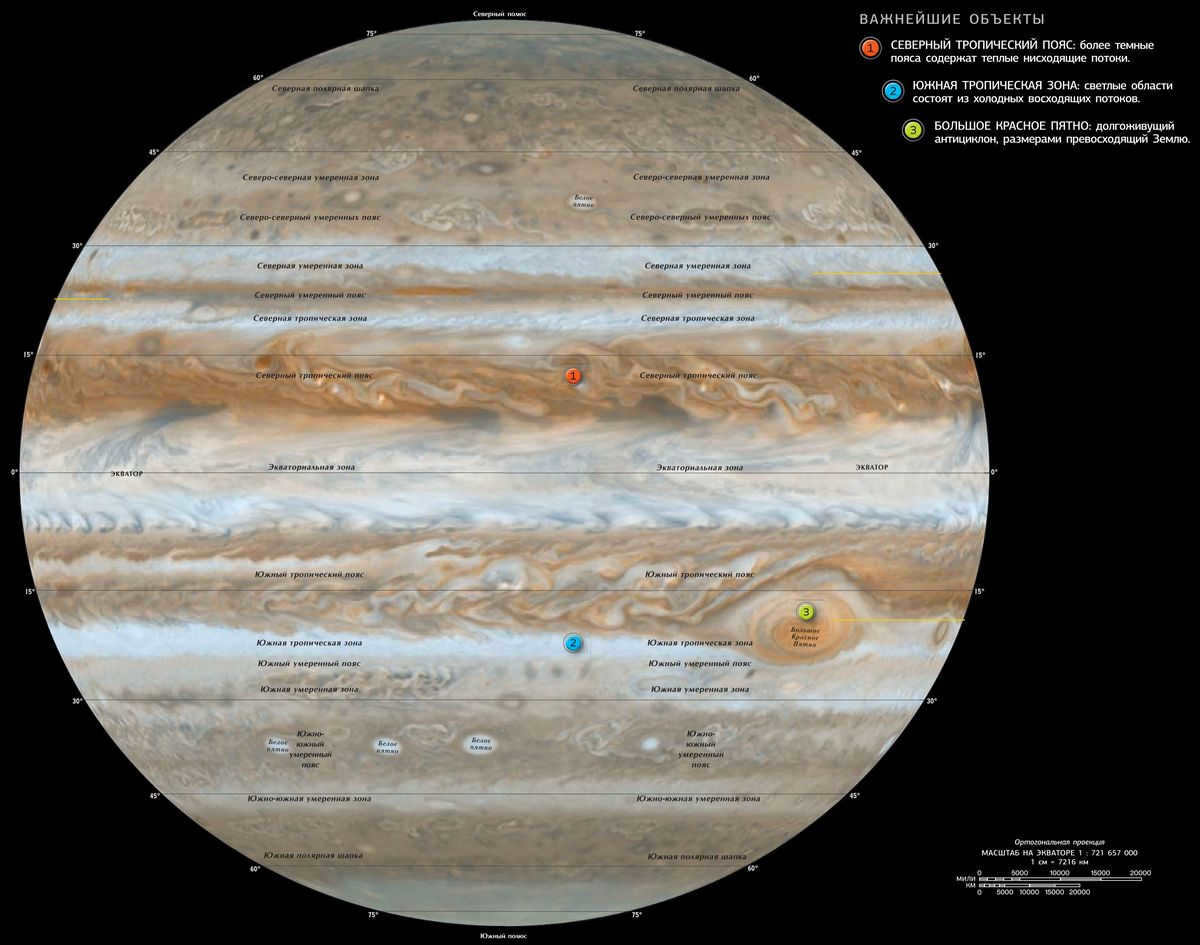
While on its journey towards its destination, the celestial body known as Saturn, the Cassini spacecraft of NASA compiled an intricate mosaic of images showcasing the planet Jupiter. Due to Jupiter’s rapid rotation, the gaseous masses surrounding it become flattened at the poles and elongated at the equator. Winds effortlessly sweep across the planet at speeds far surpassing those of Earth’s air currents. The image of Jupiter appears striped as it consists of alternating clouds of two distinct types: light clouds, which are cold and weightless, and dark clouds, which are hot and dense. At the intersection of these striped patterns, colossal storms arise, persisting for centuries.
When discussing gas giants, it is important to consider the immense pressure found at their cores. This pressure causes substances to behave in unfamiliar ways, resulting in central regions that are unlike anything we are accustomed to. Temperature is no exception, ranging from 148 °C on the surface of Jupiter’s cloud layer to approximately 24,000 °C in the gas giant’s core – a temperature exceeding that of the Sun’s surface.
A unique feature of Jupiter: an ocean of metallic hydrogen
Based on gravitational measurements, it has been discovered that Jupiter potentially harbors a small rocky core at its center, weighing approximately 20-40 times the mass of Earth. Surrounding this core is a layer of an intriguing substance, existing in an extraordinary state: metallic hydrogen. While hydrogen is commonly known as a gas or, at very low temperatures, a liquid, the extreme pressure and temperature within Jupiter’s interior cause the hydrogen atoms to become densely packed, resulting in the loss of their electrons. This creates a free electron gas, similar to the behavior of metals. It is believed that the metallic hydrogen within the giant planet exists in a liquid form, similar to the element mercury. Although rare on Earth, metallic hydrogen plays a crucial role as a fundamental component of Jupiter.
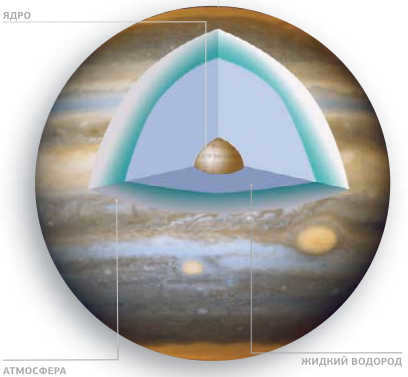
In terms of its structure, Jupiter is quite unique. Unlike our planet, it has a rocky core surrounded by a layer of metallic hydrogen, a substance that cannot be found naturally on Earth. The presence of this layer is a result of the extreme pressure and temperature within the planet.
Located above the layer of metallic hydrogen is a layer of regular liquid hydrogen. It is likely that there is no distinct boundary between these two phases, making it difficult to define a traditional “surface” on Jupiter.
The uppermost layer of Jupiter’s atmosphere is what we observe when we peer at the planet through a telescope. Its external layer is primarily composed of hydrogen and helium (comprising approximately 75% to 24% of its weight). As per one theory, the distinct bands seen on Jupiter are the product of convection within its atmosphere, caused by heat-induced rising and subsequent cooling and sinking of certain layers. The light clouds associated with the upward currents exist at a higher altitude (around 20 km) and their coloration likely stems from a greater concentration of brilliant white ammonia crystals. Conversely, the darker belt clouds beneath are believed to consist of reddish-brown ammonium hydrosulfide crystals, possess higher temperatures, and move in a downward direction. The deepest layers, only occasionally visible, exhibit a blue hue.
It is worth mentioning that the prevailing air currents on Earth blow in different directions at various latitudes. The trade winds, which blow westward between the tropics, flow from the northeast in the Northern Hemisphere and from the southeast in the Southern Hemisphere. In temperate regions, air masses move from east to west. Jupiter exhibits a similar phenomenon, but due to its rapid rotation (with a day lasting approximately 10 hours) and its immense size, it has a much greater number of atmospheric circulation bands compared to Earth. The opposing air currents in Jupiter’s atmosphere, fueled by solar heat and influenced by physical and chemical processes within its gas clouds, are responsible for the formation of the planet’s distinctive colored bands.
Jupiter asserts its dominance as the ruler of the solar system’s planets by boasting a magnetic field that is a staggering 20,000 times more powerful than Earth’s. This impressive force is believed to be generated by the movement of conductive materials within the planet’s liquid metallic core. The sheer strength of Jupiter’s magnetic field creates a powerful shock wave at the boundary where the giant’s magnetosphere meets the solar wind. Interestingly, within this boundary lie the orbits of Jupiter’s four largest moons.
The most notable characteristic of Jupiter is arguably the Great Red Spot, a massive hurricane located in the planet’s southern hemisphere. This atmospheric vortex is the largest of its kind in the entire solar system and has been observed since its discovery by Giovanni Cassini in 1665. However, it wasn’t until after 1830, when continuous observations began, that the Great Red Spot truly came to light. The spot is so vast that it could engulf the entire Earth, but its size has been steadily diminishing since the 1930s. Initially, the cross-section of the storm along its major axis measured approximately 40,000 km, but as of 2014, it had shrunk to 16,500 km. In 2006, a neighboring vortex to the Great Red Spot underwent a transformation in color from white to red, earning it the name “Lesser Red Spot.”
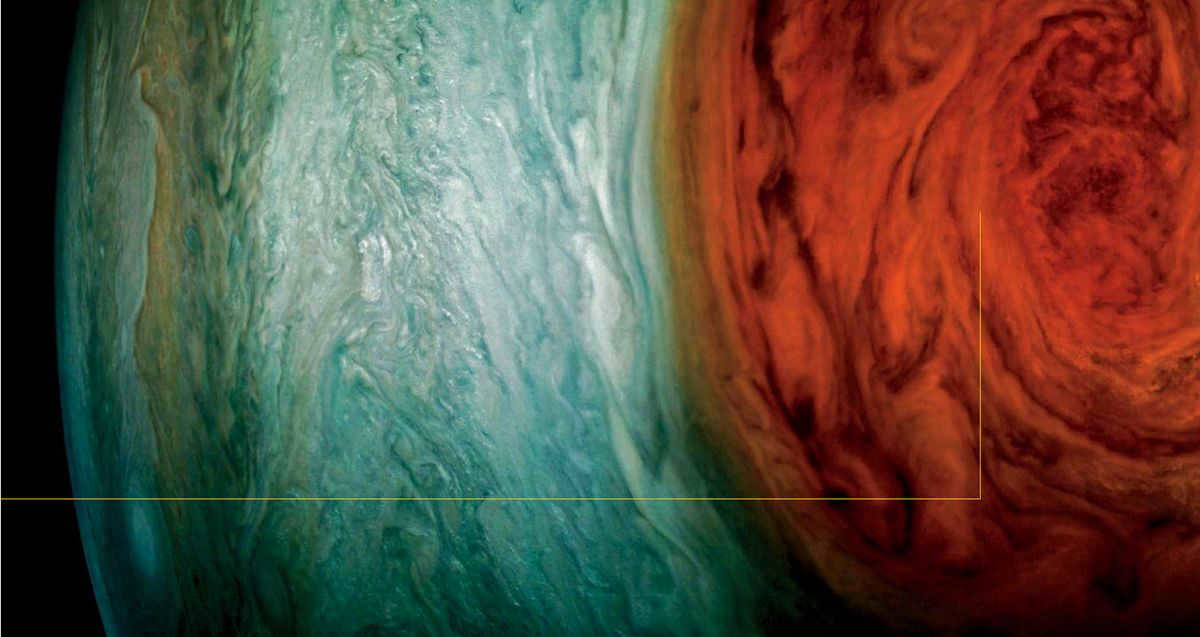
A compilation of data from the Juno spacecraft reveals the turbulent atmosphere of Jupiter, as evidenced by the image of the boundary of the Great Red Spot.
Exploring Jupiter
Jupiter, known for its brightness in the night sky, was first observed through a telescope by Galileo Galilei in 1610. Galileo also documented the planet’s satellites, making significant contributions to our understanding of Jupiter. Over the years, numerous spacecraft have passed by Jupiter on their way to other destinations. In 1979, the Voyager interplanetary station made a groundbreaking discovery, revealing that Jupiter possesses a system of rings, similar to other gas giants. Jupiter’s rings consist of three faint rings, likely formed from dust ejected by its closest satellites.
The primary mission to Jupiter is called Galileo, which was launched in 1989 and entered the planet’s orbit in 1995. That same year, it released a descent probe into the atmosphere of the massive planet. The probe gathered and transmitted data for approximately one hour before being crushed by the intense atmospheric pressure at a depth of 153 kilometers. Throughout its seven-plus years in orbit, Galileo amassed a wealth of information about Jupiter and its natural moons. In 2003, the spacecraft was intentionally directed into Jupiter’s atmosphere at a velocity of around 50 km/s, ultimately melting in its upper layers. This measure was taken to prevent the potential contamination of Jupiter’s moons, particularly Europa, with microorganisms from Earth. Scientists believe that Europa holds the potential for discovering extraterrestrial life, as we will explore later.
In August 2011, NASA initiated the launch of the Juno, an unmanned spacecraft designed for interplanetary exploration, specifically targeting the planet Jupiter. This remarkable mission, known as Juno, the Jupiter Polar Orbiter, successfully entered polar orbit around Jupiter in July 2016. The primary objective of this ambitious endeavor is to meticulously investigate the gravitational and magnetic fields of the gas giant, with a secondary aim to validate the hypothesis regarding the existence of a solid core within Jupiter. Moreover, the spacecraft is equipped to conduct an extensive analysis of the planet’s atmosphere, meticulously measuring the presence of water and ammonia, while simultaneously constructing a comprehensive map of the planet’s winds, which can reach astonishing speeds of up to 618 km/h on Jupiter. The anticipated conclusion of the mission is scheduled for July 2021, when the spacecraft will be deliberately directed out of orbit and into Jupiter’s atmosphere, effectively destroying the vessel. This deliberate termination mirrors the objective of its predecessor, the Galileo spacecraft, which aimed to prevent any potential contamination of Jupiter’s satellites by terrestrial microorganisms.
Jupiter comes under assault
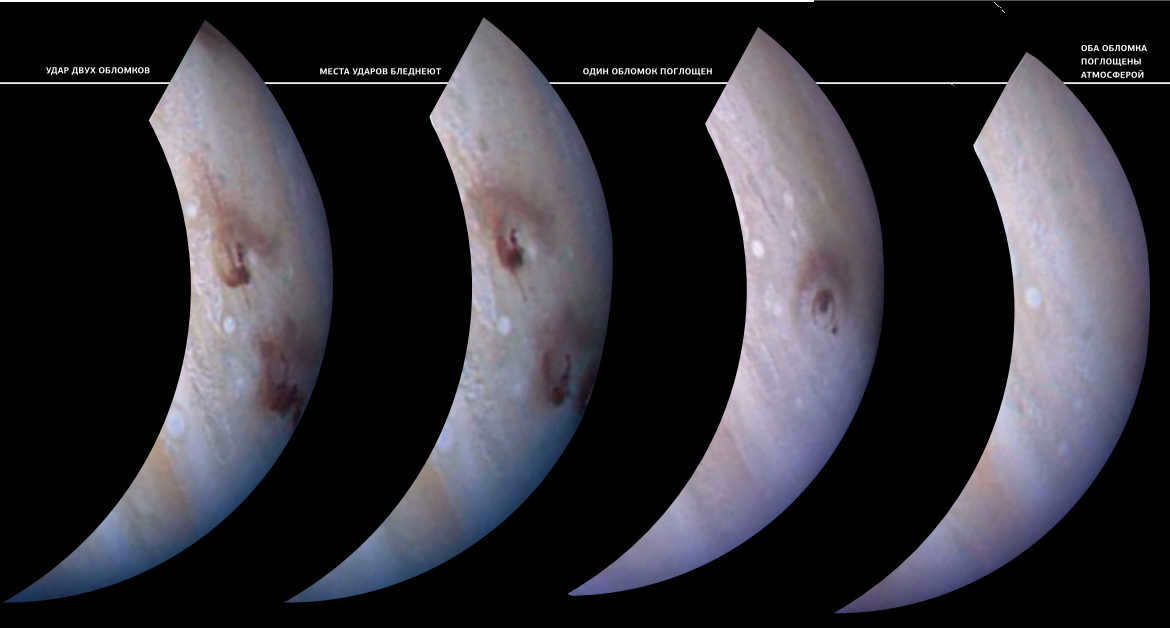
The fragments descended between July 16 and 22, resulting in significant disruptions in the cloud cover. These fragments landed in the southern hemisphere of Jupiter, on the side opposite to Earth. As a result, the Galileo apparatus, located 1.6 astronomical units away from Jupiter, was the only device able to record the real-time moments of the descent. Earthlings studied the disturbances caused by the fragments in Jupiter’s atmosphere after the planet completed a full rotation on its axis.





